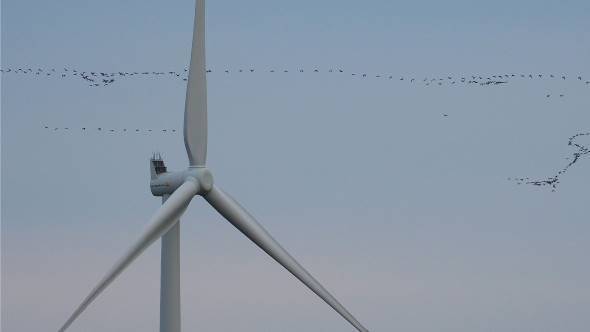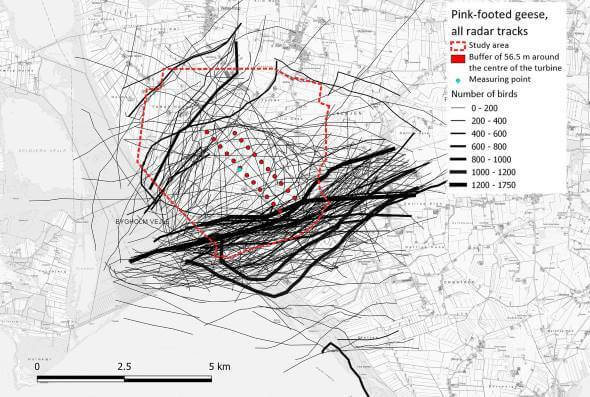News Release from Vattenfall Europe Sales GmbH
Wind Industry Profile of
Birds are good at avoiding wind turbine blades
The new study, which was carried out for Vattenfall by three experienced consultancy firms in cooperation with local ornithologists, shows that over 99 percent of the pink-footed geese and cranes that fly in the area avoid the wind turbine blades.
Klim Wind Farm is located in the immediate vicinity of the international Natura 2000 bird protection area Vejlerne. Each day, thousands of birds leave their roosting areas in Vejlerne and fly out to the nearby fields to find food, with many passing the wind farm.

Flocks of pink-footed geese near Klim Wind Farm (Image: Henrik Haaning Nielsen)
"The area is an important natural area and quite extraordinary, as 20-30,000 pink-footed geese and several hundred cranes roost here. Thousands of birds fly past the wind farm in both the morning and the evening during the winter period, which is why it's so positive to learn that the birds fly around or over the turbines to such a great extent. Hardly any of them hit the turbines, and the figure is considerably lower than previously believed," explains Jesper Kyed Larsen, Bioscience Lead at Vattenfall Environment & Sustainability.
The study was carried out partly to prove that Klim Wind Farm complies with its environmental permit, which stipulates that collisions must not exceed 75 per cent of the current sustainable mortality rates for populations of pink-footed geese and cranes.

Trajectory of pink-footed geese registered using radar with variations in width according to flock size. The red markings comprise the turbines and the study area.
It has been conducted over two periods, one and three years, respectively, after the erection of the wind farm in 2015 and is Denmark's most comprehensive study to date of how geese and cranes react to the spinning blades at a wind farm. The focus has been to calculate how many birds collide with the blades as well as how many birds fly in the area.
For three periods of just over a month in both the first and third years, the area around 11 turbines was checked every three days to see whether there were dead birds, feathers or other traces of bird remains. The number of birds in the study area was also mapped using laser binoculars, telescopes and radar, which made it possible to systematically measure distance and flight altitudes and subsequently create a 3D trajectory of each bird.
The research results are especially positive seen in the light of the growing need to erect wind turbines as part of efforts to curb climate change, as they point to the potential for the co-existence of nature and wind turbines.
"The results confirm that birds are astonishingly good at flying around or over the turbines. This is positive, not only because almost no birds die in collisions, but also because it means that the erection of wind turbines doesn't need to be in direct conflict with natural areas. This new knowledge should be taken into consideration in connection with the planning of new wind farms," says Jesper Kyed Larsen.
The results of the study will be published in DOF BirdLife Denmark's scientific journal together with a 'peer review' for professional consolidation.
About the study:
The study at Klim Wind Farm and the Natura 2000 nature reserve Vejlerne has documented the number of potential colliding birds by searching around turbines, with adjustments for what foxes and similar animals may have removed.
For both pink-footed geese and cranes, the calculated evasive response over the two study years stood at 99.9 percent based on a population of 20-30,000 geese and several hundred cranes respectively.
Neither pink-footed geese nor cranes were found where it could be stated with certainty that they had died as a result of a collision with the wind turbines.
For the sake of prudence, the study assumed that all birds or remains of birds found under the turbines could have been involved in a collision.
By comparing the potential number of collided birds with those registered in the area, what is called an 'evasive response' was calculated using the internationally recognised Band model.
The study has been conducted for Vattenfall by three recognised consultancy firms, including local professional ornithologists.
- Source:
- Vattenfall
- Author:
- Press Office
- Link:
- group-prod.vattenfall.com/...
- Keywords:
- Vattenfall, study, birds, blades, wind turbine, Denmark, nature, wind farm, consultancy firm




























